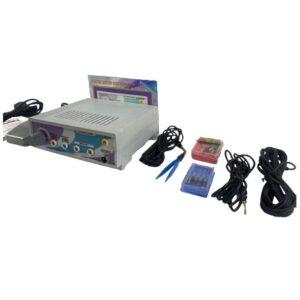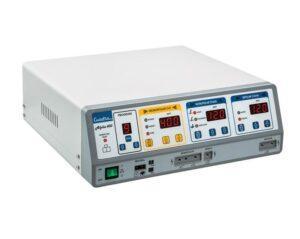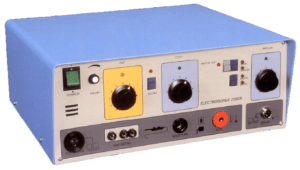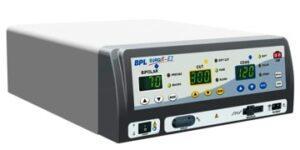Medical advancements have significantly transformed the field of surgery, introducing innovative techniques and tools to enhance precision and patient safety. Among these breakthroughs, surgical diathermy machines have emerged as a cornerstone of modern surgical practices. These state-of-the-art devices utilize high-frequency electrical currents to cut, coagulate, and seal tissues, making surgical procedures more efficient, controlled, and safe.
Different Types of Surgical Diathermy
Surgical diathermy is an indispensable tool in modern medicine, enabling surgeons to perform intricate procedures with heightened precision and improved patient safety. Within the realm of surgical diathermy, there exist distinct types of machines, each designed to cater to specific surgical applications. Let’s delve into the different types and understand their significance in the field of healthcare.
Monopolar Surgical Diathermy Machine
Among the most widely used types in surgery, the monopolar diathermy machine operates by employing a single active electrode alongside a neutral electrode. This configuration facilitates the delivery of high-frequency electrical currents to the targeted tissue. Monopolar diathermy machines excel in cutting, coagulating, and desiccating tissues, rendering them ideal for a broad spectrum of surgical procedures.
Bipolar Surgical Diathermy Machine
In contrast to the monopolar counterpart, the bipolar diathermy machine features two closely positioned electrodes, thereby restricting the electrical current’s flow exclusively between them. This type of diathermy machine finds prominence in delicate procedures where meticulous control and precision take precedence, such as neurosurgery and ophthalmic surgery.
Each type of surgical diathermy machine offers distinct advantages tailored to specific surgical requirements. It is of paramount importance for surgeons and healthcare professionals to comprehend the nuances distinguishing these machines and choose the most fitting option for each procedure. By selecting the appropriate surgical diathermy machine, surgeons can ensure optimal surgical outcomes, minimize tissue damage, and enhance overall patient safety.
How to Use a Monopolar Surgical Diathermy Machine
The monopolar surgical diathermy machine is an essential instrument in modern surgical procedures, offering precise tissue dissection, coagulation, and hemostasis capabilities. To harness its full potential and ensure optimal outcomes, here is a step-by-step guide on effectively utilizing a monopolar surgical diathermy machine.
- Preoperative Preparation: Before commencing the procedure, verify that the machine is properly calibrated and in optimal working condition. Confirm that the active electrode is securely connected to the machine, and position the patient return electrode appropriately on the patient’s body for reliable grounding.
- Select the Correct Settings: Adjust the settings on the diathermy machine according to the specific surgical requirements. Choose the appropriate mode, such as cutting, coagulation, or blend modes, based on the desired tissue effect.
- Establish the Circuit: Connect the active electrode to the diathermy machine and ensure a secure attachment of the patient return electrode to the patient’s skin. This establishes the electrical circuit necessary for the delivery of electrical current.
- Activate the Machine: Once the circuit is established, activate the monopolar surgical diathermy machine, starting with low power settings. Gradually increase the power as required during the procedure, while carefully monitoring the tissue response.
- Technique: Utilize the active electrode to perform precise tissue dissection, coagulation, or hemostasis as dictated by the surgical needs. Ensure the electrode maintains direct contact with the tissue for optimal results, controlling its movement and depth to prevent excessive tissue damage.
- Monitoring: Continuously monitor the patient’s response to the diathermy procedure, remaining vigilant for any signs of tissue damage or adverse reactions. Maintain open communication with the surgical team to ensure a coordinated approach throughout the surgery.
- Postoperative Care: Upon completion of the diathermy procedure, deactivate the machine and disconnect the active electrode. Adhere to proper disposal protocols for used electrodes and accessories, in accordance with the healthcare facility’s guidelines.
It is crucial to strictly follow the manufacturer’s instructions, adhere to safety guidelines, and undergo comprehensive training in the use of monopolar surgical diathermy machines. By employing this powerful surgical tool effectively, surgeons can enhance precision, control bleeding, and elevate the overall quality of patient care.
Everything You Need to Know about Bipolar Diathermy
Bipolar diathermy is a valuable tool in modern surgical procedures, offering surgeons a high level of control and precision. Unlike monopolar diathermy, which can cause damage to surrounding tissues due to the electrical current flowing through the patient, bipolar diathermy uses two closely positioned electrodes to deliver the current to a localized area, minimizing the risk of unintended tissue damage.
This method is especially helpful in delicate surgical operations like neurosurgery and ocular surgery, where control and precision are crucial. It also eliminates the need for a separate patient return electrode and large dispersive electrode, which can make procedures in confined spaces more challenging.
Bipolar diathermy machines offer various power settings and modes, allowing surgeons to customize the energy delivery to meet the specific needs of the procedure. Advanced safety features, such as temperature monitoring and impedance feedback systems, can also be incorporated to enhance precision and safety.
To ensure successful surgical outcomes, healthcare professionals must receive proper training in the use of bipolar diathermy machines and strictly adhere to safety protocols. Closely monitoring tissue response is essential to avoid complications and achieve optimal results. Overall, bipolar diathermy is a valuable technique that plays a crucial role in modern healthcare and surgical practice.
How Surgical Diathermy Machines Ensure Patient Safety
Surgical diathermy machines play a crucial role in ensuring patient safety during surgical procedures. These machines utilize high-frequency electrical currents to cut, coagulate, or vaporize tissues, and they incorporate various features and mechanisms to enhance patient safety. Here are some ways in which surgical diathermy machines ensure patient safety.
- Advanced Safety Features: Modern surgical diathermy machines are equipped with advanced safety features that monitor and regulate the energy delivery. These features include temperature monitoring systems that prevent overheating and impedance feedback systems that ensure safe energy delivery, minimizing the risk of thermal injury and electrical burns.
- Precise Energy Control: Surgical diathermy machines provide precise control over the energy delivered to tissues. Surgeons can adjust the power settings and modes according to the specific requirements of the procedure, ensuring that the energy delivered is appropriate and minimizing the risk of excessive or insufficient energy application.
- Minimized Tissue Trauma: By providing precise and controlled energy delivery, surgical diathermy machines minimize tissue trauma. Surgeons can target specific areas with accuracy, reducing damage to surrounding healthy tissues and promoting faster healing and recovery for the patient.
- Hemostasis and Reduced Bleeding: Surgical diathermy machines enable effective hemostasis by coagulating blood vessels during surgery. This reduces bleeding and the need for traditional sutures or clamping, minimizing blood loss and improving patient safety.
- Enhanced Surgical Precision: With the ability to coagulate, cut, desiccate, and vaporize tissues, surgical diathermy machines offer enhanced surgical precision. The risk of mistakes and complications is reduced since surgeons are more accurate while performing treatments.
- Improved Visibility: Surgical diathermy machines help maintain a clear surgical field by coagulating tissues. This increases surgeons’ visibility, enabling them to observe and manoeuvre the surgical site more efficiently, lowering the possibility of unintentional harm and raising patient safety.
- Proper Training and Adherence to Safety Protocols: To ensure patient safety, healthcare professionals must receive proper training in the use of surgical diathermy machines. To reduce the potential of difficulties and promote safe and efficient use of the technology, compliance with safety regulations, including grounding and proper handling of the equipment, is crucial.
Advantages of Using Surgical Diathermy in Gynecology
Surgical diathermy, also known as electrosurgery, offers several advantages when used in gynecological procedures. Here are the key benefits.
- Precise Tissue Control: Surgical diathermy enables gynecologists to achieve precise tissue cutting and coagulation. This level of precision is crucial for delicate procedures such as removing ovarian cysts or excising endometrial polyps, where accuracy is paramount.
- Effective Hemostasis: Diathermy machines provide excellent hemostatic capabilities by coagulating blood vessels during gynecological surgeries. As a result, there are fewer consequences related to excessive bleeding, such as the requirement for blood transfusions, and the visibility for the surgeon is improved.
- Minimized Tissue Trauma: Surgical diathermy minimizes tissue trauma by precisely targeting and sealing blood vessels. This reduces collateral damage to surrounding tissues, minimizes postoperative pain, and promotes quicker recovery for the patient.
- Enhanced Surgical Precision: Gynecological procedures often involve working in small and confined spaces. Surgical diathermy provides gynecologists with the necessary precision and control to work in these limited areas, ensuring optimal surgical outcomes.
- Reduced Operative Time: Diathermy can significantly reduce operative time in gynecological procedures. The efficient coagulation of blood vessels and precise tissue cutting capabilities contribute to shorter surgeries, which benefits patients by reducing anesthesia exposure and overall operative time.
- Gynecological Surgery Versatility: Surgical diathermy can be employed in a variety of gynaecological surgeries because to its versatility. It is commonly employed in procedures such as hysterectomies, myomectomies, endometrial ablations, colposcopies, and loop electrosurgical excision procedures (LEEP). This versatility makes it a valuable tool for gynecologists across various sub-specialties.
It is important for gynecologists to receive proper training and stay updated with the latest techniques and advancements in surgical diathermy. Adhering to safety protocols and understanding the unique considerations of diathermy usage in gynecology are crucial to maximizing its benefits and ensuring optimal patient care.
Surgical Diathermy Machines from Leading Indian Manufacturers
Radio Frequency (Surgical Diathermy)
 The Radio Frequency (Surgical Diathermy) by Kara Mediclust Pvt Ltd is a powerful and reliable surgical tool manufactured in India. This advanced device utilizes high-frequency radio waves to perform tissue dissection, hemostasis, and coagulation with exceptional precision and control. Whether you require monopolar or bipolar RF surgical instruments, this electrosurgery RF generator provides superior performance, making it an ideal choice for a wide range of surgical procedures. With its comprehensive range of RF surgical equipment, including handpieces and accessories, this device is particularly well-suited for minimally invasive RF surgery. Additionally, it delivers excellent results in plastic surgery, cosmetic procedures, dermatology, oncology, spine and neurosurgery, as well as gastroenterology and urology surgeries.
The Radio Frequency (Surgical Diathermy) by Kara Mediclust Pvt Ltd is a powerful and reliable surgical tool manufactured in India. This advanced device utilizes high-frequency radio waves to perform tissue dissection, hemostasis, and coagulation with exceptional precision and control. Whether you require monopolar or bipolar RF surgical instruments, this electrosurgery RF generator provides superior performance, making it an ideal choice for a wide range of surgical procedures. With its comprehensive range of RF surgical equipment, including handpieces and accessories, this device is particularly well-suited for minimally invasive RF surgery. Additionally, it delivers excellent results in plastic surgery, cosmetic procedures, dermatology, oncology, spine and neurosurgery, as well as gastroenterology and urology surgeries.
ASF Bipolar Coagulator
 The ASF Bipolar Coagulator, manufactured by A.S.F. Universal, is a leading surgical diathermy machine from India. This innovative device operates efficiently at lower voltages, requiring less energy during procedures. The forceps electrode of the coagulator grasps tissues on both sides, effectively delivering electrosurgical current only to the area between the forceps’ arms. This focused current minimizes harm to delicate tissues and provides enhanced control over the targeted region, reducing the risk of patient burns. Surgeons can utilize the forceps attached to the electrosurgical generator, making the ASF Bipolar Coagulator an indispensable tool in various surgical procedures.
The ASF Bipolar Coagulator, manufactured by A.S.F. Universal, is a leading surgical diathermy machine from India. This innovative device operates efficiently at lower voltages, requiring less energy during procedures. The forceps electrode of the coagulator grasps tissues on both sides, effectively delivering electrosurgical current only to the area between the forceps’ arms. This focused current minimizes harm to delicate tissues and provides enhanced control over the targeted region, reducing the risk of patient burns. Surgeons can utilize the forceps attached to the electrosurgical generator, making the ASF Bipolar Coagulator an indispensable tool in various surgical procedures.
Electrosurge 250EB
The Electrosurge 250EB, manufactured by Technomed Electronics, is an advanced endoscopic surgical diathermy unit based on solid-state microcontroller technology. With its separate bipolar section and provision for hand switch operation, this model offers exceptional versatility. It is particularly suitable for endoscopic polypectomy, where the snare is energized by the diathermy using micro currents. The Electrosurge 250EB complies with international safety standards, ensuring patient well-being during surgical procedures. Whether for micro or macro surgeries, its various modes of operation, easy power level selection, and patient safety features make it a reliable and efficient surgical tool.
Alpha Series
 Cuadra Medical Technology Pvt. Ltd. presents the Alpha Series, an innovative line of surgical diathermy devices manufactured in India. These cutting-edge devices utilize high-speed microcontrollers to deliver precise output power supply, ensuring accurate surgical performance. The Alpha Series offers unmatched usability with feather touch buttons, a digital display, and programmable settings, enabling surgeons to optimize their surgical diathermy experience. With various modes in monopolar cut, monopolar coagulation, and bipolar coagulation, including micro and precise options, the Alpha Series caters to diverse surgical needs. Its ability to save current settings during power outages ensures uninterrupted surgical procedures, making it the preferred choice for surgeons across specialties.
Cuadra Medical Technology Pvt. Ltd. presents the Alpha Series, an innovative line of surgical diathermy devices manufactured in India. These cutting-edge devices utilize high-speed microcontrollers to deliver precise output power supply, ensuring accurate surgical performance. The Alpha Series offers unmatched usability with feather touch buttons, a digital display, and programmable settings, enabling surgeons to optimize their surgical diathermy experience. With various modes in monopolar cut, monopolar coagulation, and bipolar coagulation, including micro and precise options, the Alpha Series caters to diverse surgical needs. Its ability to save current settings during power outages ensures uninterrupted surgical procedures, making it the preferred choice for surgeons across specialties.
SurgiX E2
BPL Medical Technologies Private Limited introduces SurgiX E2, a highly innovative and high-performance surgical diathermy machine. Equipped with advanced feedback technology and safety monitoring features, this device ensures precise power delivery and patient safety during surgical procedures. With a monopolar mode of 300W and a bipolar mode of 70W, the SurgiX E2 offers a wide range of power options for different tissue types. It includes multiple monopolar cut and coagulation modes, as well as bipolar modes for precise and macro applications. Surgeons can rely on the SurgiX E2 to maintain a higher level of power across a range of tissues, enabling optimal surgical outcomes.
Conclusion
In conclusion, surgical diathermy machines play a crucial role in modern medicine, particularly in various surgical specialties. Their advantages, such as precision, hemostasis, reduced tissue trauma, and enhanced surgical outcomes, make them invaluable tools for healthcare professionals.
In gynecology, surgical diathermy offers precise tissue control, effective hemostasis, and minimized tissue trauma, contributing to improved patient outcomes and faster recovery. Similarly, in cardiothoracic surgery, diathermy provides hemostasis, precise tissue dissection, and vaporization capabilities, aiding surgeons in achieving successful procedures with reduced surgical trauma.
To avoid complications in surgical diathermy, proper training, equipment maintenance, patient safety precautions, careful electrode selection and handling, and utilizing monitoring and feedback systems are essential. Communication and coordination within the surgical team further enhance safety and prevent errors.
As technology continues to advance, surgical diathermy machines will evolve, offering even more innovative features to support surgical procedures. Staying updated with the latest advancements and continuously improving skills and knowledge in diathermy usage are crucial for healthcare professionals.
By embracing the power of surgical diathermy machines and adhering to safety guidelines, healthcare professionals can elevate their surgical practice, improve patient outcomes, and contribute to the advancement of medical science.




